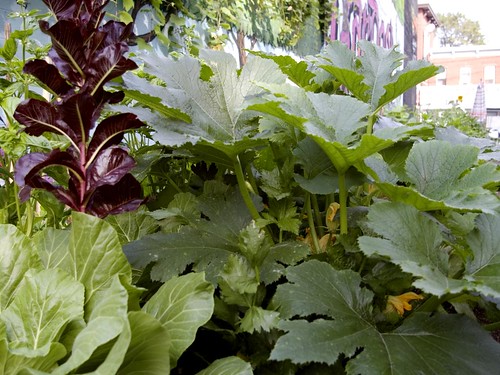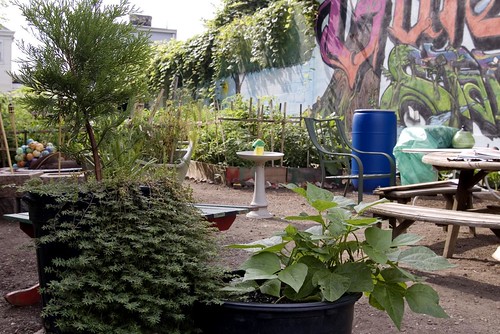Just a reminder about the out-going First Lady. Originally posted on 8.31.12.
The way I see it, the smart money is on First Lady Michelle Obama, not to do a Hillary and go for the Big One in a later Presidential Ritual Contest (aka election). No, to do an Eleanor (Roosevelt) and have a major effect on the nation while her husband does the military strut.
How, pray tell, will she do this? you ask. With her garden, says I, with her garden.
Veggies for Health
As you may know, she’s very much interested in gardening, in particular, growing vegetables. She’s set up a garden on the Whitehouse lawn, grown veggies, had them served in the Whitehouse and has recently published a book on gardening and nutrition.
That’s her angle on gardening. Vegetables are good and good for you. They’re essential to a proper diet, and a proper diet is necessary to prevent childhood obesity.
Her interest in and commitment to gardening is deep, predating her husband’s nomination:
"Back then, it was really just the concept of, I wonder if you could grow a garden on the South Lawn?" Michelle Obama says. "If you could grow a garden, it would be pretty visible and maybe that would be the way that we could begin a conversation about childhood health, and we could actually get kids from the community to help us plant and help us harvest and see how their habits changed."She was a city kid from Chicago's South Side who had never had a garden herself, though her mother recalls a local victory garden created to produce vegetables during World War II. One childhood photo included in the book shows Michelle as an infant in her mother's arms — the resemblance between Marian Robinson in the picture and Michelle as an adult is striking — and another depicts a young Michelle practicing a headstand in the backyard.... After the election, she broached her idea to start the first vegetable garden on the White House grounds since Eleanor Roosevelt's victory garden in the 1940s.Since the garden's groundbreaking in 2009 — just two months after the inauguration — she has hosted seasonal waves of students from local elementary schools that help plant the seeds. Groundskeepers and dozens of volunteers weed and tend the garden. Charlie Brandts, a White House carpenter who is a hobbyist beekeeper, has built a beehive a few feet away to pollinate the plants and provide honey that Michelle Obama says "tastes like sunshine."
So, the First Lady has a garden on the Whitehouse lawn and she’s preaching the garden gospel. Good enough.
Gardens in the Transition
The thing is, regardless of why a family or a community decides to grow a vegetable garden, the moment they start doing so, they’re also participating in the Transition Movement. By that I mean the movement started by Rob Hopkins in England and that now has groups all over the world:
Now, I’ve not heard the First Lady say anything about gardening as a response to peak oil and climate change, nor do I expect to. It isn’t even necessary. All she has to do is to continue to encourage people to grow those vegetables. As they do so they will be doing something that is a necessary part of the transition—growing food locally and thereby contributing to local resilience—and people will begin to strengthen those “civic muscles” that have atrophied in a world of Big Systems run by Big Brothers looking over us for Our Own Good.The Transition Movement is comprised of vibrant, grassroots community initiatives that seek to build community resilience in the face of such challenges as peak oil, climate change and the economic crisis. Transition Initiatives differentiate themselves from other sustainability and "environmental" groups by seeking to mitigate these converging global crises by engaging their communities in home-grown, citizen-led education, action, and multi-stakeholder planning to increase local self reliance and resilience. They succeed by regeneratively using their local assets, innovating, networking, collaborating, replicating proven strategies, and respecting the deep patterns of nature and diverse cultures in their place. Transition Initiatives work with deliberation and good cheer to create a fulfilling and inspiring local way of life that can withstand the shocks of rapidly shifting global systems.
I can see it happening in my own neighborhood in Jersey City. We have a new community garden and people are proud of it. WE have done this. It’s OURS. And we’re only beginning.
Finally, consider the mythology. In the Abrahamic religions—that’s the founding Mothers and Fathers of the USofA—humankind started in a garden. Gardens are spaces of growth and renewal, with a touch of anarchy and jubilee thrown in. It’s a natural: Return to the Garden.
As People Re-Take Public Space
The garden’s the First Lady advocates are happening already, and they’re just one aspect of the spontaneous flourishing of Temporary Autonomous Zones (TAZ), to borrow a term from Hakim Bey. And TAZ’s are on the way UP. Occupy Wall Street turned Zuccotti Park in Lower Manhattan into a TAZ, but that’s just the tip of the iceberg.
Consider the United States Pavilion at the Venice Architecture Biennale this Fall, the most prestigious architecture event in the world. It’s theme is Spontaneous Interventions: Design Actions for the Common Good:
In recent years, there has been a nascent movement of designers acting on their own initiative to solve problematic urban situations, creating new opportunities and amenities for the public. Provisional, improvisational, guerrilla, unsolicited, tactical, temporary, informal, DIY, unplanned, participatory, opensource—these are just a few of the words that have been used to describe this growing body of work.
Here’s part of the curators’ statement:
But around the world, scores of people and organizations are intervening directly in their own environments, bringing incremental improvements to their streets, blocks, and neighborhoods. These acts of micro-urbanism, of informal urban design, are characteristically small in scale, and often temporary—the opposite of the qualities we traditionally associate with good design—yet their power resides not so much in their forms as in their impacts, in their immediate ability to infuse places with value and meaning.Spontaneous Interventions celebrates a movement for democratic change in cities in the United States, inspired by a kindred activism around the world. The actions—planting abandoned lots, occupying and reprogramming public spaces, and generally making cities more beautiful, inclusive, productive, and healthy—are planning at its most direct, expressions of a desire for good places that cannot simply await the sanction of the “authorities” to find their form. As these small but powerful works multiply and coalesce, a just and sustainable city, a city of all its communities, is being born. This is a celebration of a long and vibrant history of urban activism and takes particular pride in representing the U.S. during the tenure of a president whose career began as an urban community organizer.
That pavilion is being sponsored by the U.S. Department State, which is no agent of anarchy, nosirreebob. But history has cast them in that role anyhow.
A Stealth Obama in the Whitehouse
Now, if I’d had my druthers, I’d rather have a non-Republicrat in the Whitehouse, someone not tied to the apron strings of Big Finance, someone committed to getting all the troops home yesterday, and someone who opposes Big Oil and Big Nukes. But I don’t see that happening this time around. When it comes down to it, I’d certainly prefer Obama over Romney.
But the real treasure is Michelle “Stealth” Obama and her gardens. Let Barack run interference for her while she does Eleanor in the Garden all over country, North, South, East, and West. Spreading razzmaTAZ while getting kids to eat their veggies, and the kids get their parents to eat their veggies. In the process, maybe the parents will do like Popeye on spinach and grow some civic muscle.
All behind the scenes. Under the radar.
It’s our best chance.



No comments:
Post a Comment